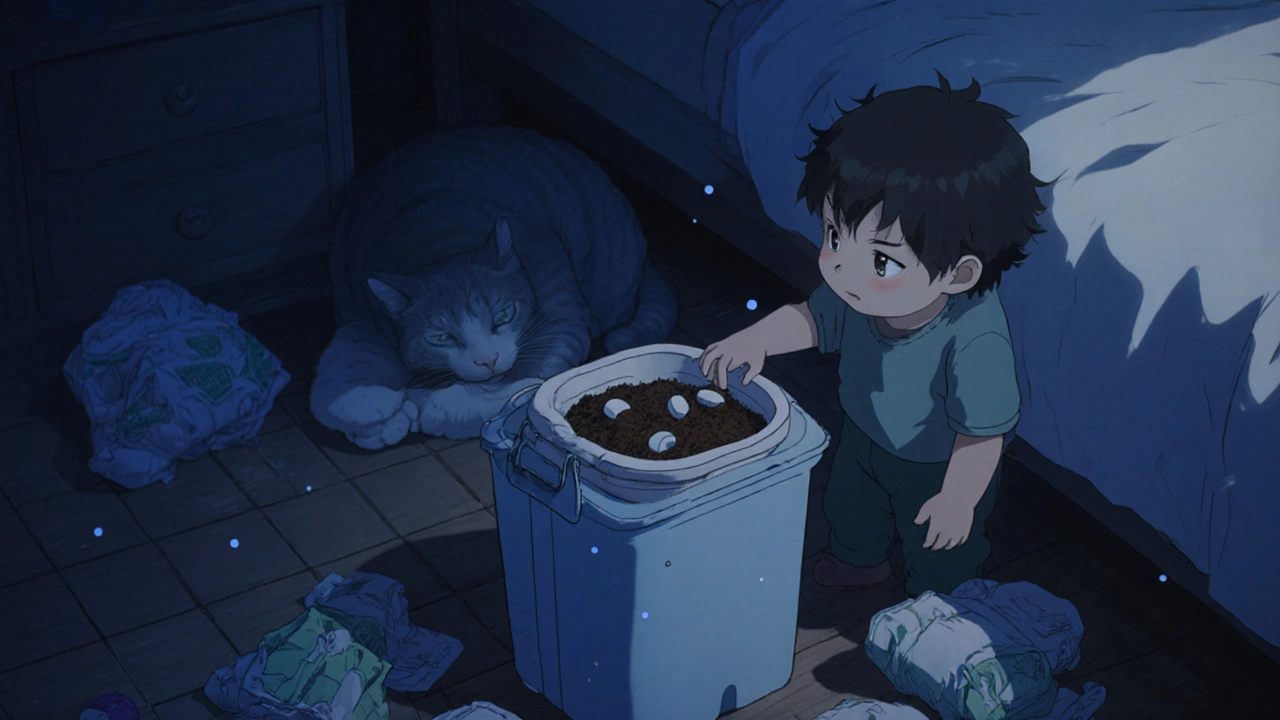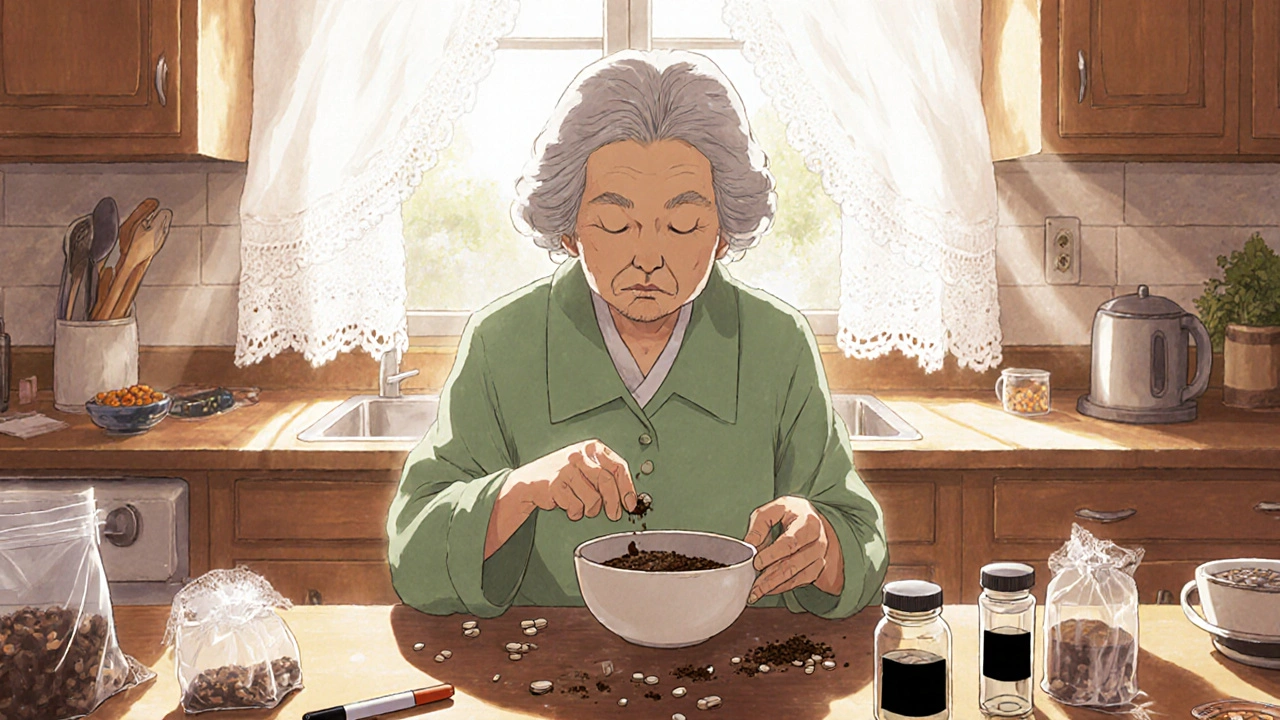Keeping unused or expired medications in your medicine cabinet isn’t just messy-it’s dangerous. Every year, thousands of children accidentally swallow pills they find at home. Others misuse them, sometimes with deadly results. And when you flush or toss pills carelessly, they end up in waterways and landfills, harming wildlife and contaminating drinking water. The good news? You can safely get rid of them using your household trash-if you do it right.
Why You Can’t Just Toss Pills in the Trash
Throwing pills directly into the trash sounds simple, but it’s risky. Someone-maybe a curious kid, a pet, or even a person looking for drugs-can dig through your garbage and find them. Prescription bottles often have your name, address, and dosage clearly printed. That’s not just a privacy issue; it’s a safety hazard. Plus, pills can leak or break open, spilling chemicals into the soil and groundwater over time. The FDA and EPA agree: the best way to dispose of most medications is through a drug take-back program. But not everyone lives near one. In rural areas, the nearest collection site might be 30 miles away. That’s why household trash disposal is a necessary backup-and it works, if you follow the rules.Step 1: Check if Your Medication Is on the FDA Flush List
Before you even think about the trash, check if your drug is on the FDA’s Flush List. This list includes 15 high-risk medications that are so dangerous if misused that flushing is the safest option. These are mostly powerful opioids like oxycodone, fentanyl patches, and benzodiazepines like alprazolam. If your medication is on this list, flush it down the toilet immediately. Don’t wait. Don’t mix it. Don’t store it. You can find the full list on the FDA’s website, but here are a few common ones: Remifentanil, Fentanyl patch, Oxycodone extended-release, Buprenorphine/naloxone, and Pentazocine. If you’re unsure, check the package insert or call your pharmacist. If it’s not on the list, move to the next step.Step 2: Remove Medications from Original Containers
Take all pills, liquids, creams, or patches out of their original bottles. This isn’t optional. Those bottles have your personal information-your name, doctor’s name, prescription number. That’s protected under HIPAA. Leaving it visible means someone could steal your identity or use your prescription details to get more drugs. Use a permanent marker to black out your name, address, and prescription number. If you don’t have a marker, cover the label with duct tape or scratch it with a key. Don’t just peel it off-the adhesive often leaves readable traces. For liquid medications, pour them into a sealable plastic bag before removing the bottle.Step 3: Mix Medications with an Unappealing Substance
This is the most important step. You’re not just throwing pills away-you’re making them impossible to use. Mix them with something gross, sticky, or smelly. Used coffee grounds work great. Cat litter is even better-it’s clumpy, smells bad, and animals avoid it. Dirt, sawdust, or even used paper towels soaked in vinegar also work. Use at least a 1:1 ratio. If you have 10 pills, mix them with an equal amount of coffee grounds. For liquids, pour them into a small container of cat litter or absorbent material. Don’t crush pills. That can create dust you might breathe in, especially with strong medications like fentanyl. Just drop them in whole.
Step 4: Seal the Mixture in a Leak-Proof Container
Once mixed, put the whole thing into a container that won’t leak or break. A resealable plastic bag is fine. So is an empty yogurt tub, a margarine container, or even a glass jar with a tight lid. The goal is to make it impossible for someone to spill or scoop out the mixture. Seal it tightly. If you’re worried about leaks, double-bag it. Don’t use flimsy containers like paper cups or thin plastic bags. They tear easily. And never leave the mixture in the original pill bottle-even if you’ve removed the label. Those bottles are easy to open and still look like medicine.Step 5: Put It in the Trash, Not the Recycling
Place the sealed container in your regular household trash. Put it where it won’t be easily found-maybe at the bottom of the bin, under old food wrappers or diapers. That adds another layer of protection. Don’t put pill bottles in recycling. Most are made of #5 plastic (polypropylene), which 87% of U.S. recycling programs can’t process. Even if your city says they take #5, the caps and labels make them contamination risks. Just toss them in the trash too.What Not to Do
Here are the biggest mistakes people make:- Flushing non-listed medications-this pollutes water supplies and harms aquatic life.
- Throwing pills in the trash without mixing them-someone can still find and use them.
- Leaving labels readable-this invites identity theft and drug misuse.
- Crushing pills-this can release dangerous fumes or powder you might inhale.
- Using commercial disposal products as a substitute for mixing-most are unnecessary. Coffee grounds and cat litter work just as well.



I did this last week with my grandma's leftover oxy. Used coffee grounds and a yogurt tub. She’s 82 and had 17 bottles. Felt like a tiny act of rebellion against the pharmaceutical industrial complex. 🤷♀️
Oh wow. So you’re telling me we’re supposed to *mix* our opioids with cat litter? Like some kind of postmodern art installation? I mean, sure, it’s ‘safe’-but it’s also profoundly *uncouth*. The FDA should be embarrassed. This isn’t disposal-it’s performance art for the suburban proletariat. 🤭
You got this. Seriously. Taking five minutes to do this right is one of the most caring things you can do-for your family, your neighbors, even the fish. Small acts, big ripple effects. 💪
This guide is literally the most boring thing I’ve ever read. 🙄 I mean, who even *has* cat litter lying around? And why am I supposed to care about fish? I’m just trying to not get sued by my kid who found my Xanax. 🤡
I must express my profound appreciation for the meticulousness of this guidance. The adherence to public health protocols, the consideration of environmental stewardship, and the prioritization of privacy under HIPAA are not merely commendable-they are, in fact, civic virtues. One hopes such diligence becomes the norm, not the exception.
I wonder if this is really about safety… or if it’s just another way society tells us to be afraid of our own medicine. Like, why do we even have so much left over? Shouldn’t we be asking why we’re prescribed so much in the first place?
Mate, this is brilliant. I’ve been doing this since I moved to the States. Used coffee grounds, double-bagged, buried under old pizza boxes. My neighbors think I’m weird, but hey-my dog’s still alive and the creek’s clean. 🍃
Let’s be real-this whole thing is a distraction. The real problem is that Big Pharma floods the market with opioids and then tells us to ‘dispose responsibly’ like we’re the ones breaking the system. Also, cat litter? Really? That’s the best we’ve got? Pathetic.
The EPA’s guidelines are statistically inadequate. The bioaccumulation of pharmaceutical metabolites in aquatic ecosystems exceeds permissible thresholds by 3.7x according to the 2023 WHO meta-analysis. Your coffee grounds are a placebo intervention. You’re not solving the problem-you’re performing performative compliance.
I don’t care if it’s ‘safe’-if you’re not flushing it, you’re a traitor to American infrastructure. We’ve got landfills full of this junk because people won’t just do what the FDA says. And don’t get me started on those ‘take-back’ programs-taxpayer waste.
I just crushed my pills and threw them in the toilet. 🤫我妈说这样不对,但我妈是中国人,她不懂美国的规矩 😅
i did the coffee grounds thing but i think i used too much and now my trash smells like a hippie campfire 🤭
this helped me out a lot. i used to just toss the bottles in the trash till i read this. now i use old cereal boxes to seal the mix. no more scary labels. thanks for the tip.